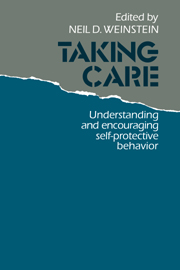Book contents
- Frontmatter
- Contents
- List of contributors
- Acknowledgments
- Introduction: studying self-protective behavior
- I Theoretical perspectives
- 1 Behavioral decision theory perspectives on protective behavior
- 2 Social learning theory and preventive behavior
- 3 The role of emotion and psychological defense in self-protective behavior
- 4 The diffusion of innovations perspective
- 5 Cultural influences on prevention and the emergence of a new health consciousness
- II Research and prevention programs for specific hazards
- III Conclusion
- Index
5 - Cultural influences on prevention and the emergence of a new health consciousness
Published online by Cambridge University Press: 03 February 2010
- Frontmatter
- Contents
- List of contributors
- Acknowledgments
- Introduction: studying self-protective behavior
- I Theoretical perspectives
- 1 Behavioral decision theory perspectives on protective behavior
- 2 Social learning theory and preventive behavior
- 3 The role of emotion and psychological defense in self-protective behavior
- 4 The diffusion of innovations perspective
- 5 Cultural influences on prevention and the emergence of a new health consciousness
- II Research and prevention programs for specific hazards
- III Conclusion
- Index
Summary
Introduction
Americans have increasingly come to see themselves at risk. Despite all the attention given to the difficulty of modifying hazardous behaviors – and in part because of the attention these behaviors have received – the past decade has been characterized by a dramatic turn toward self-protection. Millions of people are making new efforts to reduce their exposure or susceptibility to physical health hazards and millions more are declaring their desire to do more for their health.
We are witnessing the most massive reversal of smoking behavior in our history. More than 30 million people have stopped smoking since 1964, when 42% of adults smoked. By the end of 1983, the percentage had dropped to 29 (USDHHS, 1983: 260, Chicago Sun Times, 1984). A number of studies indicate that the consumption of salt, total fat, saturated fat, and cholesterol is down (USDHHS, 1983: 263). The streets, gymnasiums, parks, and a rapidly expanding number of health clubs are overflowing with joggers and exercisers. For 1979, estimates were that between 15 and 25 million were jogging. A Harris poll the same year found that 37% of those interviewed were regularly exercising (Gillick, 1984: 379). A 1979 Yankelovich survey found that “46% of American adults reported recently changing the lifestyles of themselves and their families in the interest of good health” (USDHHS, 1980: 293–4).
- Type
- Chapter
- Information
- Taking CareUnderstanding and Encouraging Self-Protective Behavior, pp. 95 - 114Publisher: Cambridge University PressPrint publication year: 1987
- 22
- Cited by



